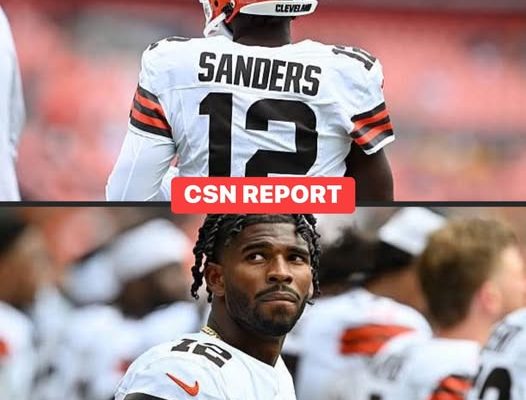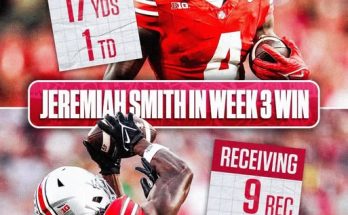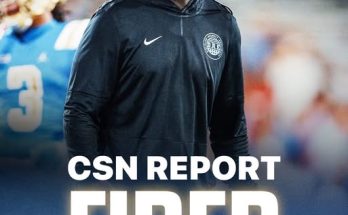The Baltimore Ravens, known for their strategic approach to the NFL Draft and their willingness to adapt on the fly, reportedly had plans to select Shedeur Sanders in the fifth round of this year’s draft, using the 141st overall pick. According to league sources cited by ESPN, the Ravens had identified Sanders as a potential addition to their roster, seeing value in the talented quarterback’s skill set and the versatility he could bring to the team. However, what initially seemed like a straightforward plan quickly evolved into a shift in strategy due to Sanders’ own preferences and career considerations.
Shedeur Sanders, the son of Hall of Famer Deion Sanders, has long been recognized for his exceptional talent and his ability to perform at a high level in college football. His poise in the pocket, accurate passing, and ability to read defenses made him an intriguing prospect for NFL teams looking to bolster their quarterback depth or potentially groom a future starter. For the Ravens, selecting Sanders could have provided both an immediate backup to Lamar Jackson and a developmental player who might eventually challenge for the starting role. The prospect of pairing a dynamic quarterback like Sanders with the Ravens’ historically strong offensive scheme held a certain appeal for the organization.
Despite the potential benefits of joining Baltimore, Sanders reportedly communicated that he was not interested in being drafted by a team where he would be expected to sit behind Lamar Jackson. The two-time MVP, widely regarded as one of the league’s most elite quarterbacks, remains firmly entrenched as the Ravens’ starter. Recognizing that Jackson’s status as the team’s primary quarterback was unlikely to change anytime soon, Sanders sought a clearer path to significant playing time. The decision highlights the modern athlete’s increasing awareness of career trajectory, playing time, and the importance of finding a situation conducive to development. For a young quarterback entering the NFL, sitting on the bench behind an established star can limit growth opportunities and delay the chance to showcase talent on a national stage.
The Ravens, who have historically valued flexibility and strategic planning in their draft decisions, were reportedly receptive to Sanders’ preferences. While drafting a talented quarterback like Sanders in the fifth round could have been a relatively low-risk move, the organization understood the importance of aligning their selections with the desires of their prospective players. NFL teams often face the challenge of balancing talent acquisition with player buy-in, recognizing that an athlete who is motivated and enthusiastic about joining the team is more likely to thrive. In this instance, Sanders’ explicit desire for a situation with more immediate opportunity prompted the Ravens to pivot in their draft strategy.
As a result of Sanders’ decision, the Ravens shifted their focus and ultimately selected offensive lineman Carson Vinson with the 141st overall pick. Vinson, who brings his own set of skills and potential to the organization, represents a strategic investment in a position that has long been a cornerstone of the Ravens’ success. Offensive linemen are critical to protecting the quarterback, establishing the run game, and providing stability along the offensive front. While Vinson’s selection may not have the immediate headline appeal of drafting a quarterback, it underscores the Ravens’ commitment to building a roster that balances talent across positions and addresses team needs.
The situation with Sanders also reflects broader trends in the NFL regarding player agency and draft dynamics. In recent years, athletes have increasingly asserted their preferences regarding team fit, coaching staff, and potential playing time. This shift challenges traditional notions of draft authority, as organizations must now consider not only a player’s talent but also their willingness to embrace a specific role. Sanders’ decision to prioritize playing time and career trajectory exemplifies this growing awareness among athletes. By communicating his intentions clearly before the draft pick was made, he allowed both himself and the Ravens to avoid a potentially awkward situation that could have affected morale and development.
For the Ravens, the pivot to selecting Vinson represents a pragmatic approach to roster building. While the quarterback position is undoubtedly critical, the organization’s ability to adjust in real time demonstrates the depth of their scouting and strategic planning. Draft decisions in the NFL are rarely linear, with teams constantly weighing positional value, player availability, and long-term development. The willingness to adapt when circumstances change is often what separates successful franchises from those that struggle to maintain competitiveness. By securing an offensive lineman with clear potential, the Ravens not only addressed a positional need but also ensured that their draft capital was used effectively in alignment with both team priorities and player intentions.
From Sanders’ perspective, prioritizing a team where he has a clearer path to playing time is a calculated move designed to maximize both development and visibility. For young quarterbacks entering the league, the opportunity to take meaningful snaps early in their careers can be instrumental in shaping long-term success. Being relegated to a backup role behind a franchise quarterback, even one as talented as Lamar Jackson, can delay the acquisition of in-game experience and limit exposure to NFL defenses. By making his preferences known, Sanders positioned himself to join a team where he can compete for playing time sooner, accelerating his learning curve and increasing his chances of establishing himself as a starter in the league.
This scenario also highlights the delicate balance NFL teams must strike between evaluating talent and managing expectations. While teams often identify players they believe fit their systems, the human element—player motivation, personal goals, and career ambitions—can influence outcomes significantly. Sanders’ decision illustrates the importance of transparent communication between teams and prospective players, ensuring that both parties can make informed choices that serve long-term interests. For franchises, understanding a player’s mindset and willingness to embrace a role is as critical as assessing physical ability and football intelligence.
The broader implications of this development extend beyond the Ravens and Sanders. In an era where player mobility and agency are increasingly emphasized, NFL teams may need to adapt their draft strategies to account for individual preferences more systematically. Athletes who actively seek the best environment for their growth are reshaping how organizations approach talent acquisition, emphasizing collaboration, fit, and alignment with personal objectives. This dynamic may lead to more instances where draft plans are adjusted in response to a player’s communicated intentions, reflecting a shift from a purely top-down approach to a more nuanced, interactive process.
For fans, the story of Sanders and the Ravens provides insight into the complex considerations that underlie draft decisions. While headlines often focus on first-round selections and marquee prospects, the later rounds can involve intricate maneuvering, negotiations, and real-time adjustments that significantly impact team composition. Sanders’ decision not to join the Ravens demonstrates that the draft is as much about human factors and strategic alignment as it is about raw talent evaluation. Similarly, the selection of Vinson underscores the value of positional depth and the importance of ensuring that each pick serves the team’s broader goals.
Ultimately, the episode reflects the evolving landscape of the NFL draft, where player preferences, team strategy, and long-term development considerations intersect. For the Ravens, it was a moment to exercise adaptability and make a choice that aligns with organizational needs while respecting the autonomy of the athlete. For Sanders, it was a deliberate decision to prioritize opportunity and career trajectory, demonstrating a keen understanding of what is necessary to succeed at the highest level. While neither outcome is inherently dramatic, both represent thoughtful decision-making that highlights the professionalism and foresight required in today’s NFL.
The Ravens’ ability to pivot and select an offensive lineman after Sanders’ decision illustrates their resilience and strategic depth. NFL teams often face scenarios where ideal targets are unavailable or unwilling to join, and the capacity to make informed, alternative choices can define a season’s trajectory. Vinson now joins a franchise with a strong track record of developing talent and maximizing player potential, and his addition could strengthen the offensive line, providing immediate and future benefits to the team. The decision-making process also reinforces the notion that draft selections are not merely transactional; they involve assessment, negotiation, and alignment with broader team objectives.
For Sanders, the decision signals a commitment to his own development and long-term success in the league. By seeking an environment where he can compete for playing time, he demonstrates a proactive approach to career management. In an era where quarterbacks are the most scrutinized and celebrated positions, gaining early experience and the opportunity to showcase skills on the field can be pivotal. Sanders’ approach reflects a modern mindset in professional sports, emphasizing agency, strategic thinking, and self-awareness.
In summary, the reported scenario involving the Baltimore Ravens and Shedeur Sanders offers a nuanced glimpse into the complexities of NFL draft decision-making. The Ravens’ initial plan to select Sanders in the fifth round, followed by his expressed preference to pursue a team where he could have more immediate opportunities, led to a pivot that ultimately resulted in the selection of offensive lineman Carson Vinson. The situation underscores the evolving nature of player-team dynamics, highlighting the importance of communication, strategic flexibility, and alignment of expectations. For the Ravens, it was an opportunity to demonstrate adaptability and make a choice that strengthens the roster. For Sanders, it was a calculated decision to prioritize playing time, development, and long-term career prospects. The episode reflects broader trends in professional sports where athletes increasingly assert agency over their career paths and teams must balance talent evaluation with individual preferences. Both parties navigated the situation thoughtfully, illustrating professionalism, strategic foresight, and a keen awareness of the factors that contribute to success in the highly competitive environment of the NFL.
The Ravens’ draft maneuvering and Sanders’ strategic decision-making serve as a microcosm of the modern NFL landscape. They highlight the interplay between player aspirations and organizational strategy, illustrating how individual preferences can shape outcomes and influence team construction. The scenario exemplifies how professional sports are not only about talent on paper but also about fit, opportunity, and timing. As the NFL continues to evolve, instances like this provide valuable insight into the sophisticated considerations behind draft choices, offering a deeper appreciation of the thought processes that drive both player decisions and team strategy.
Both the Ravens and Sanders emerge from this episode with clarity and purpose. Baltimore reinforced its commitment to addressing positional needs while maintaining roster flexibility, and Sanders positioned himself to pursue an environment conducive to growth and immediate impact. The situation is a reminder that behind every draft pick lies a web of decisions, negotiations, and strategic considerations that extend far beyond the simple act of selecting a player. It also underscores the agency athletes possess in shaping their professional trajectories, reflecting a broader shift in how talent acquisition and player development intersect in the modern NFL.
In the end, the story of Shedeur Sanders and the Baltimore Ravens is not merely about a draft pick that did or did not happen; it is about the thoughtful navigation of opportunity, ambition, and strategic planning. It demonstrates the significance of clear communication, respect for player priorities, and the necessity of adaptability in achieving both individual and organizational objectives. As Sanders embarks on the next chapter of his professional career and the Ravens continue to build a team around Lamar Jackson and complementary talent, the episode serves as a case study in modern NFL strategy, providing lessons in both player empowerment and organizational agility that resonate throughout the league.



